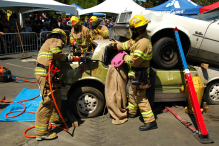Firefighters must be trained for so much more than fire fighting. As public servants on the front lines, firefighters are often the first on the scene for any number of cataclysmic events. One of the most common incidents that firefighting professionals encounter is car accidents; unfortunately, some of these accidents will require that victims be extricated from their vehicles. It is precisely such cases that call for the expertise only found in those who have successfully completed vehicle extrication training.

Every accident has its own characteristics. The vehicle's make and model, the accident's location, the position of the vehicle, and the severity of the victim's injuries are just some of the factors that must weigh heavily on how the professionals address each situation; however, the result must remain the same--safely removing the victim from an entirely unsafe environment in an expedient amount of time.
Since there are so many variables in an accident, it is essential that some of the basic strategies for such cases be invariable. Consider, for instance, some of the following parameters that must be considered, no matter the conditions:
- Stabilization has always been one of the first tasks for the responding crew, but today offers a variety of new products that more quickly and efficiently complete this step. Keeping up with this new equipment takes recent and specialized training.
- Just as with the stabilization devices, there is new glass removal equipment that allows the glass to be taken out in a more controlled manner so that neither the victim nor the responders are sprayed with additional glass. This equipment also allows the responders more access to the victim.
- Removing the door provides the best access to the victim, but each vehicle's make and model provides a different set of principles that must be employed. Where brute force may work okay in certain circumstances, finesse is better used in another. Crews must be trained to recognize which to use when.
- Like door removal, roof removal proves to be quite challenging. Where a door can possibly be removed by a single firefighter, a roof will require a team effort. Crews must be trained to recognize the sequence of cuts that should be made for successful roof removal.
- Once the door and/or roof is removed, it's not at all uncommon to find the victim pinned down by the dashboard. It is paramount that crews know how to handle this situation when it arises, and it will. Whether jacking with spreaders, rolling using rams, or using any other technique, crews must have the training they need to perform this task quickly and efficiently. At the scene is never the time to talk about theories that may or may not work.
While the NFPA standards provide the principles and best practice guidelines for safely removing a trapped victim from a vehicle, those standards will not prove at all helpful without the proper training. Please contact us today to discover how our training arms all first responders with the expertise that saves precious seconds on site.
